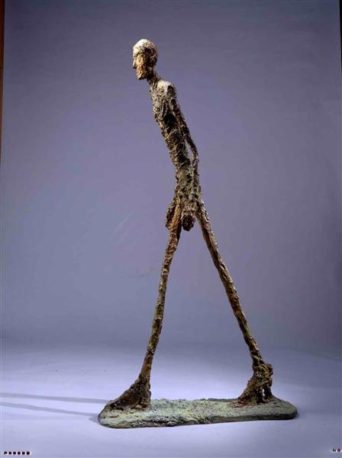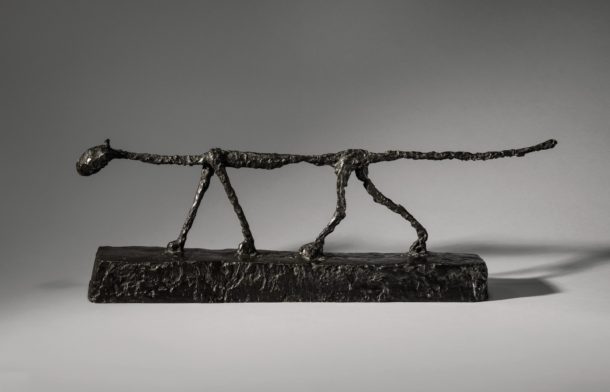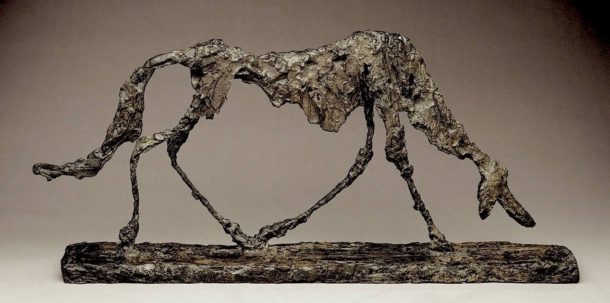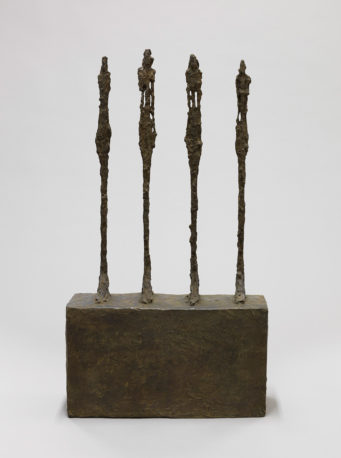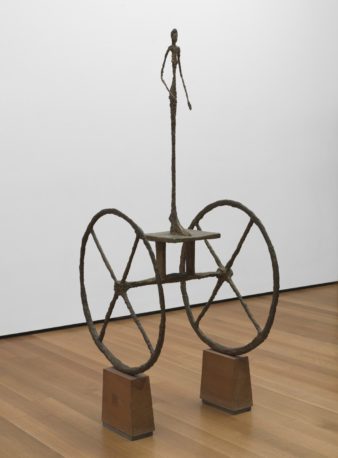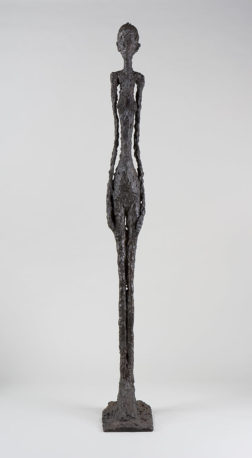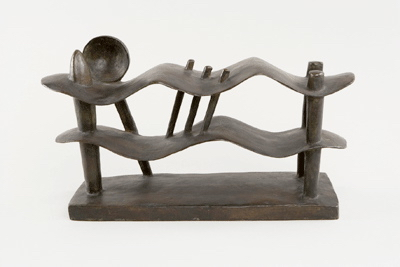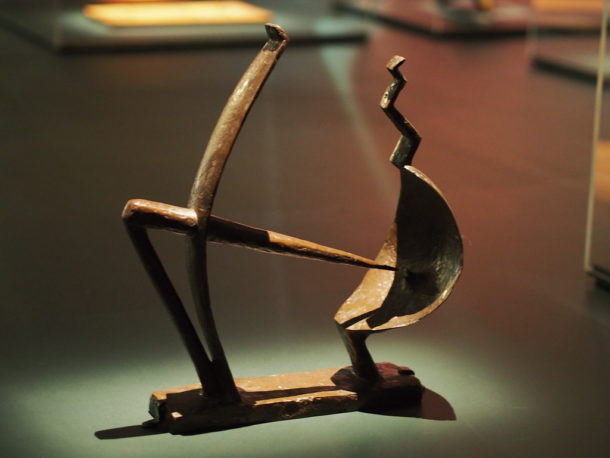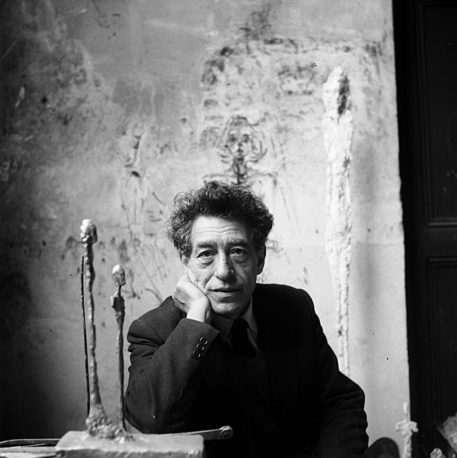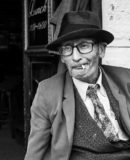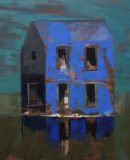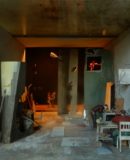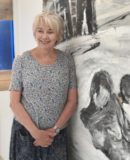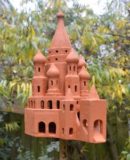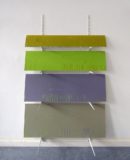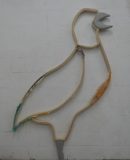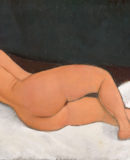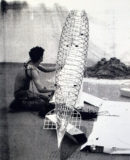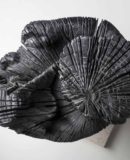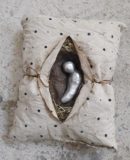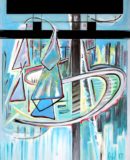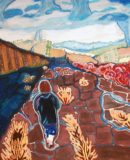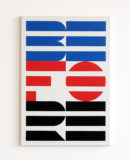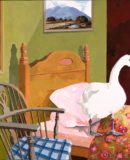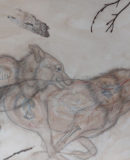World Fine Art Professionals and their Key-Pieces, 348 - Alberto Giacometti
World Fine Art Professionals and their Key-Pieces, 348 – Alberto Giacometti
Alberto Giacometti is known and loved for his tall, thin bronze human figures. He made these images in the period 1945 – 1960 and was inspired by people hurrying in the big city. Giacometti is fascinated by man in motion, which he sees as ‘a succession of moments of stillness’.
In the exhibition ‘Picasso – Giacometti’, which I recently visited in Museum Voorlinden, there were various skinny figures such as his ‘L’ Homme qui marche II’ from 1960, but lean elongation was also visible in the work ‘The nose’, an image of a thin man’s head, with a thin nose, longer than Pinocchio’s nose ever was.
Picasso and Giacometti were constantly exchanging ideas from their first meeting in 1931. The age difference of 20 years didn’t matter that much. They explored surrealism in the 1930s and had endless conversations after 1945 about the return to realism. After 1945 they each found their own form.
First sculpture
Alberto Giacometti was born in 1901 in Switzerland, in Borgonovo in the canton of Graubünden. He is the oldest of four children. The family moves to Stampa in the Bregaglia Valley in 1906, where his father, Giovanni, painter, converts the barn of the house into a studio. Alberto is also going to try it in 1913. He makes portraits of members of his family and his classmates, using his father’s post-impressionist style.
His first sculpture, executed in the years 1913-14, is a bust of his brother Diego. From 1915 to 1919 he continues his studies at the college of Schiens, near Chur, where he uses a small workshop. At the end of his compulsory schooling in 1919, he goes to Geneva to study at the École des beaux-arts and the École des arts et métiers, where he enrolls in the sculpture class.
In 1920 and 1921 he travels to Italy. He discovers cities, Venice, Padua, Rome, Florence and Assisi, but also painters such as Tintoretto, Giotto and Cimabue, who stayed with him for the rest of his life.
Paris
Alberto arrives in Paris on January 7, 1922. He stays in Archipenko’s studio and visits Antoine Bourdelle’s studio with whom he will work at the Académie de la Grande Chaumière in Montparnasse. He visits the Louvre and sees the Greek sculptures. He discovers Cubism, African art and is inspired by it. His sculptures are in plaster, sometimes painted or cast in bronze, a technique he will practice until the end of his life.
In December 1926 he moved to 46 Rue Hippolyte-Maindron in the 14th arrondissement. In a small studio of only 23 square meters he will always continue to work. His brother Diego joins him in 1930 to assist him. Although most of his production takes place in Paris, Giacometti regularly returns to Switzerland to work in his father’s workshop in Stampa.
In 1926, 1927 and 1928 he exhibits his first works at the Salon des Tuileries. In 1929 he works with Diego for the decorator Jean-Michel Franck. He decorates the boutique of Elsa Schiaparelli, for whom he makes jewellery and he signs a contract with Pierre Loeb, one of the most important avant-garde art dealers.
The Surrealists
He makes a series of cubist sculptures and then ‘flat’ (Woman, 1929) and ‘open’ (Homme et Femme, 1929) sculptures, with which he stands out. Meanwhile, a new movement has emerged in Paris: Surrealism. He becomes acquainted with some of these artists, notably Joan Miró and Jean Arp, and exhibits with them at Galerie Pierre. He meets more surrealists including Tristan Tzara, René Crevel, Louis Aragon, André Breton, Salvador Dalíen, André Masson. In 1931 he officially joins the Paris Surrealist group.
He makes engravings and drawings to illustrate books by René Crevel, Tristan Tzara and André Breton. He will write reviews about the works of the members of the group, including the review ‘Surrealism in the service of the revolution’. With the group, from October to November 1933, he took part in the 6th Salon des surindépendants in the company of Man Ray, Yves Tanguy, Salvador Dali, Max Ernst, Victor Brauner, Joan Miró, Vassily Kandinsky, Jean Arp and Meret Oppenheim. During this show he presented his work ‘L’oiseau silence’. Fear, dreams, uncertainty and violence are the hallmarks of his sculptures in this period.
New York
His father, Giovanni Giacometti, dies on June 25, 1933 in Glion, near Montreux. Alberto is overwhelmed with grief. The following year, he organizes a major exhibition in memory of his father. 1934 is marked by his first exhibition in the United States, which is held at Julien Lévy’s in New York. From 1935 to 1940 he tries in vain to work from a model: nothing works as he imagines. As a result, he is no longer allowed to join the surrealists. However, his sculptures are still presented in various surrealist exhibitions.
Geneva
From 1942 to 1944 Giacometti lives in Geneva, where he met his future wife Annette Arm. Diego manages to maintain his studio in Paris. After returning to Paris, Annette joins him. Giacometti marries her in 1949. His most productive period begins with his wife as muse and main model. The exhibition in Voorlinden includes various Annette-inspired sculptures and paintings.
Giacometti’s new style makes itself felt, characterized by high, thread-like figures. His production is stimulated by the relations he renewed with the New York merchant Pierre Matisse, who organizes his first post-war personal exhibition in January 1948. In 1950, Matisse organizes an exhibition of some of his most famous works: Quatre femmes sur socle, Quatre figurines sur pedestal, La Forêt, La Clairière, The Cage, The Chariot, The Woman. Diego made sure that they became bronze statues.
Paris again
In 1951, his first post-war exhibition takes place in Paris, at the Maeght gallery. There he presents works already on display in the Matisse gallery and several new works, all in plaster, including ‘Le Chat and Le Chien’. In 1960 he creates his most important sculpture of all his work, ‘Walking Man I’. This sculpture is considered a masterpiece in art history.
Showered with honour
At the end of his life, Giacometti was showered with honors. He won the Carnegie Prize in 1961, the Grand Prize for Sculpture at the Venice Biennale in 1962, where an entire room was dedicated to him, the Guggenheim Prize in 1964 and the Grand Prix International des Arts, awarded by France in 1965. In 1962 a major retrospective exhibition with more than 100 sculptures and 85 paintings took place at the Kunsthaus in Zurich.
He died in 1966 from heart disease and chronic bronchitis. He was buried in Borgonovo, close to his parents.
His work can be found in the collections of many important museums and sculpture parks.
Images
1) Walking Man I, 1960, 2) Le chat, 3) Le chien, 4) Quatre femmes sur socle, 5), Le Nez, 6) The Chariot, 7) Tall Woman, 8) Woman, 1929, 9) Homme et Femme, 1929, 10) Alberto Giacometti
Disclaimer: The views, opinions and positions expressed within this guest article are those of the author Walter van Teeffelen alone and do not represent those of the Marbella Marbella website. The accuracy, completeness and validity of any statements made within this article are not guaranteed. We accept no liability for any errors, omissions or representations. The copyright of this content belongs to Walter van Teeffelen and any liability with regards to infringement of intellectual property rights remains with the author.

